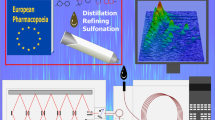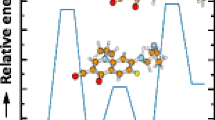Abstract
Gliclazide (GL, C15H21N3O3S) drug is used as non-insulin-dependant diabetes mellitus. The drug was investigated using thermal analysis (TA) measurements (TG/DTG) and electron impact mass spectral (EI–MS) fragmentation at 70 eV techniques. The mass spectra of GL at different values of ion source temperatures (400, 416, 425, and 440 K) are recorded and investigated. Semiempirical MO calculation, using PM3 procedure, has been carried out on neutral molecule and positively charged species. These calculations included bond length, bond order, bond strain, partial charge distribution, ionization energy, and heats of formation (ΔH f). PM3 procedure provides a basis for fine distinction among sites of initial bond cleavage, which is crucial to the rationalization of subsequent fragmentation of the molecule. The primary fragmentation pathway in both TA and MS (at different values of ion source temperature) is initiated by S–N bond rupture. TA and DTG show one main weight loss at 250.38 °C and four peaks at 271.6, 360.99, 427.93 and 479.17 °C in DTA, which may be attributed to various fragments. Also, the rate constant (K′) of thermal degradation has been tested isothermally at 210 and 600 °C. The calculated rate values are 9.6 × 10−3 and 0.33 × 10−3 s−1, respectively, and discussed. In MS, the effect of ion source temperature on mass spectral fragmentation processes is discussed on the basis of energy considerations using quasi equilibrium theory.









Similar content being viewed by others
References
Palmer KJ, Brogden RN. Gliclazide, an update of its pharmacological properties and therapeutic efficiency in non-insulin-dependent diabetes mellitus. Drugs. 1993;46:92–125.
Zhou K, Donnelly L, Burch L, Tavendale R, Doney ASF, Leese G, et al. Loss-of-function CYP2C9 variants improve therapeutic response to sulfonylureas in type 2 diabetes: a go-DARTS study. Clin Pharmacol Ther. 2010;87(1):52–6.
Kuo CY, Wu SM. High-performance liquid chromatography with electrochemical detection for analysis of gliclazide in plasma. J Chromatogr A. 2005;1088:131–5.
Najib N, Idkaidek N, Beshtawi M, Bader M, Admour I, Alam SM, et al. Bioequivalence evaluation of two brands of gliclazide 80 mg tablets (Glyzide & Diamicron)—in healthy human volunteers. Biopharm Drug Dispos. 2002;23:197–202.
Moreshwar PP, Naresh JG. Preparation and characterization of gliclazide-polyethylene glycol 4000 solid dispersions. Acta Pharm. 2009;59:57–65.
Vijayalakshmi P, Devi VK, Narendra C, Srinagesh S. Development of extended zero-order release gliclazide tablets by central composite design. Drug Dev Ind Pharm. 2008;34(1):33–45.
Shaodong J, Lee WJ, Ee JW, Park JH, Kwon SW, Lee J. Comparison of ultraviolet detection, evaporative light scattering detection and charged aerosol detection methods for liquid-chromatographic determination of anti-diabetic drugs. J Pharm Biomed Anal. 2010;51(4):973–8.
Wang CY, Zhang W, Xiang BR, Yu LY, Ma PC. Liquid chromatography–mass spectrometry method for the determination of gliclazide in human plasma and application to a pharmacokinetic study of gliclazide sustained release tablets. Arzneimittelforschung. 2008;58(12):653–8.
Hozey G, Lamiable D, Trenque T, Robinet A, Kaltenbach ML, Havet S, Millart H. Identification and quantification of 8 sulfonylureas with clinical toxicology interest by liquid chromatography–ion-trap tandem mass spectrometry and library searching. Clin Chem. 2005;51(9):1666–72.
Feng CH, Yang CM, Lu CY. Trace analysis of gliclazide in human plasma at microscale level by mass spectrometry. J High Resolut Chromatogr. 2009;32(20):3411–7.
Pang W, Yang H, Wu Z, Huang M, Hu J. LC-MS–MS in MRM mode for detection and structural identification of synthetic hypoglycemic drugs added illegally to ‘natural’ anti-diabetic herbal products. Chromatographia. 2009;70(9–10):1353–9.
Austin CA. To dissociate or decompose: investigating gas phase rearrangement of simple to complex compounds using mass spectrometry and thermal analysis. Ohio link Digital Resource (DRC); 2008.
Xaaoling HU, Zheng Y, Sun J, Shang L, Wang G, Zhang H. Simultaneous quantification of benazepril, gliclazide and valsartan in human plasma by LC-MS-MS and application for rapidly measuring protein binding interaction between rhein and these three drugs. Chromatographia. 2009;69(9–10):843–52.
Bourcier S, Hoppilliard Y. Fragmentation mechanisms of protonated benzylamines. Electrospray ionisation-tandem mass spectrometry study and ab initio molecular orbital calculations. Eur J Mass Spectrom. 2003;9:351–60.
Fahmy MA, Zayed MA, Keshk YH. Comparative study on the fragmentation of some simple phenolic compounds using mass spectrometry and thermal analyses. Thermochem Acta. 2001;366:183–8.
Biswal S, Sahoo J, Murthy PN. Characterization of gliclazide-PEG 8000 solid dispersions. Trop J Pharm Res. 2009;8(5):417–24.
Fahmey MA, Zayed MA, El-shobaky HG. Study of some phenolic-iodine redox polymeric products by thermal analyses and mass spectrometry. J Therm Anal Calorim. 2005;82:137–42.
Bansal G, Singh M, Jindal KC, Singh S. Characterization of mass ionizable degradation products of gliclazide by LC/ESI-MS. J Liq Chromatogr Relat Technol. 2008;31(14):2174–93.
Mohamed GG, Abdallah SM, Nassar MMI, Zayed MA. Metal complexes of gliclazide. Preparation, spectroscopic and thermal characterization. Biological potential study of sulphonylurea gliclazide on the house fly, Musca domestica (Diptera–Muscidae). Arab J Chem. 2009;2(2):109–17.
Zayed MA, Fahmey MA, Hawash MF. Investigation of diazepam drug using thermal analyses, mass spectra and semi-empirical MO calculations. Spectrochim Acta A. 2005;61:799–805.
Zayed MA, Hawash MF, Fahmey MA. Structure investigation of codeine drug using mass spectra, thermal analyses and semi-empirical MO calculations. Spectrochim Acta A. 2005;64:363–71.
Mohamed GG, Abdallah SM, Zayed MA, Nassar MMI. Biological potential study of metal complexes of sulphonylurea glibenclamide on the house fly, Musca domestica (Diptera-Muscidea): preparation, spectroscopic and thermal characterization. Spectrochim Acta A. 2009;74:637–41.
Stewart JJP. Optimization of parameters for semiempirical methods I. J Comput Chem. 2004;10(2):209–20.
Baker J. An algorithm for the location of transition states. J Comput Chem. 2004;7(4):385–95.
Stewart JJP. MOPAC2000. Tokyo: Fujitsu Limited; 1999.
Hrusak J, Tkaczyk M. Mndo study of fragmentations in mass spectrometry. Part II. Substituent effects in the ionization of [CH3–CO–R] compounds and their enol tautomers. Org Mass Spectrom. 1990;25:214–8.
Loew G, Chadwick M, Smith D. Applications of molecular orbital theory to the interpretation of mass spectra. Prediction of primary fragmentation sites in organic molecules. Org Mass Spectrom. 1973;7:1241–51.
Gross JH. Mass spectrometry—a textbook. Berlin: Springer-Verlag; 2004.
Author information
Authors and Affiliations
Corresponding author
Rights and permissions
About this article
Cite this article
Zayed, M.A., Nour El-Dien, F.A., Hawash, M.F. et al. Mass spectra of gliclazide drug at various ion sources temperature. J Therm Anal Calorim 102, 305–312 (2010). https://doi.org/10.1007/s10973-010-0734-8
Received:
Accepted:
Published:
Issue Date:
DOI: https://doi.org/10.1007/s10973-010-0734-8




